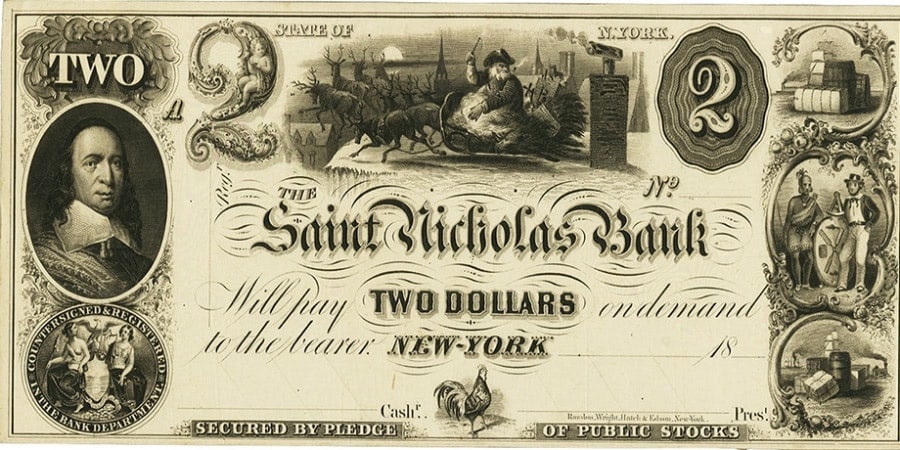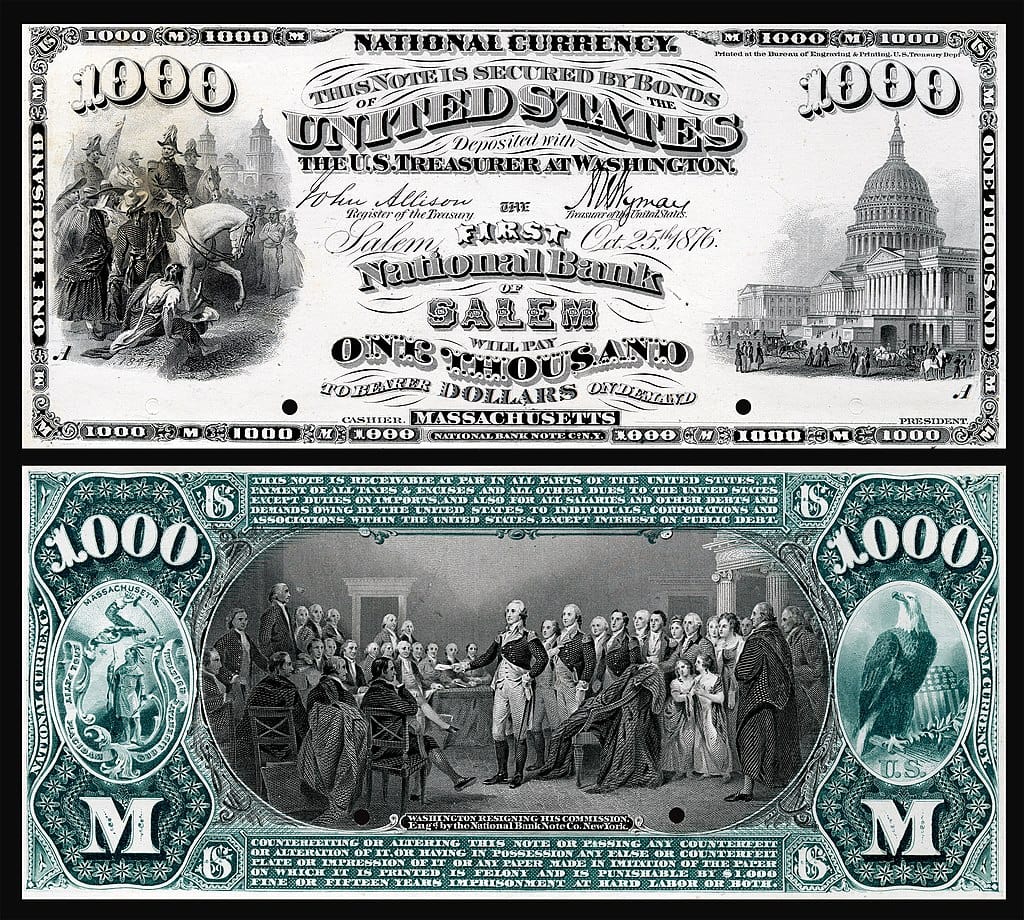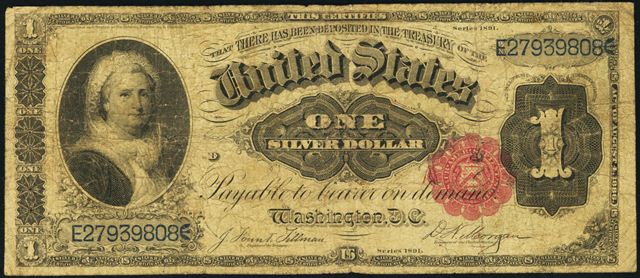Enemies have been predicting its collapse for more than a year, and it still remains the most recognized world currency.
-
1.
Origin of the name -
2.
Origin of the dollar symbol -
3.
Decentralized dollar -
4.
The paper era of the dollar: portrait gallery, denominations and symbols -
5.
Dollar in art
Although the national currencies of various countries (from developed Australia and Canada to the island states of Oceania and Central America) bear the name “dollar”, when we hear this word, our imagination forms the image of green pieces of paper with portraits of American presidents. We will focus on the history of the American dollar.
Origin of the name
The prototype of the dollar is a medieval coin of the Kingdom of Bohemia – a Central European state within the Holy Roman Empire. It was minted near a silver mine in the Joachim valley (Joachimstal). After the name of the area, the coin was called “Joachimsthaler”, which over time was shortened to “thaler”. It spread all over the world, and its name changed according to the linguistic characteristics of different peoples: among the Danes, it became “daler”, and among the English, it became “dollar”.
For example, in colonial America, a Spanish silver coin equal to eight reales was called a dollar.
The most famous slang name for the dollar is “bucks”. This name has a hunting origin. In the 18th century, the words “buck” (buck) and dollar were interchangeable concepts, since a hunter could get $1 worth of goods for the skin of a male deer (“buck”) at the trading desk.
In turn, one skin of a male deer was equal to two skins of a female deer, three skins of a raccoon, and four skins of a muskrat.
Origin of the dollar symbol
A famous symbol $ (with one or two vertical lines) has several versions of its origin, but the only true one has not been chosen so far.
There is greater unanimity of opinion regarding which of them are false.
Yes, the name of the country – US (United States) – is definitely not encrypted in the dollar symbol, since this sign appeared even before the United States.
But the dollar sign can really contain the letters U and S – from “units of silver”.
However, the “Spanish” theories of the origin of the sign are more reliable. A fairly authoritative version is considered to be the origin of the $ symbol from the abbreviation of the word “peso” – p.s. After it, at first, the abbreviated name of the monetary unit was written next to the sums in trade documents, and later from the letter p only a vertical line remained, which was superimposed on the letter s. For example, in a letter dated 1778, the same amount was written using the abbreviation ps, followed by a sign similar to $.
Decentralized dollar
For almost 120 years – from the founding of the United States to the First World War – American monetary units did not have a single manufacturing center. At that time, the following forms of the dollar were in circulation:
- Gold and silver coins. The first American coins were minted in 1792.
- Gold and silver paper certificates – a type of paper money that can be exchanged for gold or silver bars. Certificates were issued by the US Treasury.
- Paper banknotes of commercial banks. It is to private financial institutions that we owe the appearance of Santa Clauses and pastoral paintings on dollar bills. Before the Civil War of 1861-1865, there were about 10,000 different banknotes in circulation. A huge part of them were fakes or were put into circulation by bankrupt or non-existent banks.








- Greenbacks (from green back – green side) – paper money that appeared in 1862, during the Civil War in the USA in conditions of a growing budget deficit. Actually, due to the uncontrolled emission of this means of payment, greenbacks began to quickly lose their value relative to gold.








In 1913, after the formation of the Federal Reserve System (performs the functions of the central bank), a new era of the dollar began, and the anarchy in the field of production of American monetary units was ended.
The paper era of the dollar: portrait gallery, denominations and symbols
The gallery of portraits on US dollar bills contains a single image of a woman. She was honored with this honor Martha Washington – the first lady of the USA, wife of George Washington. A silver certificate with her portrait in good condition can now fetch more than $1,000.

And here is her husband, the first president of the United States George Washington, did not immediately take its usual place on the one-dollar bill. He flaunted himself on a banknote issued during the civil war Salmon Chase, then Minister of Finance. In 1869, the banknote was modified and an image of Washington appeared on it.
But Salmon Chase was not offended either. His image is included on the most expensive current US banknote – $10,000. The first banknote of this denomination was printed in 1918, but for almost the entire time of its operation, it exceeded the average American’s own capital, so few people could hold it in their hands.

In 1934, even more impressive bills were printed – $100,000 with a portrait Woodrow Wilson. Their main purpose was to transfer funds between Federal Reserve banks, so they were not used in retail operations.

Depicted on the $20 banknote Andrew Jackson was an ardent opponent of the introduction of paper money into circulation. In his opinion, only gold and silver coins should be the only means of payment. For him to say about modern payment transactions, which are increasingly becoming a collection of ones and zeros?
Since 1969, bills with the highest denomination of $100 have been printed in the United States, but bills with denominations from $500 to $10,000 are also in circulation.
Number of bills in circulation as of December 31, 2019, billion
- $100 is 14.2
- $1 is 12.7
- $20 is 9.5
- $5 – 3.2
- $10 is 2.1
- $50 is 1.8
- $2 – 1.3
- $500 – $10,000 – 0.0004 (about 400,000)
Over the past decades, there has been a permanent redesign of dollar bills – from $5 to $100. In the 1990s, domestic TV screens even broadcast a special advertisement about the appearance of the new banknotes. But one-dollar bills have not changed since 1963, because they are hardly counterfeited.
According to information from the Federal Reserve System, the one-dollar bill is the cheapest to manufacture – only 5.4 cents per bill. The most expensive is the $50 bill – 19.4 cents per bill.
Believe it or not, American dollars are not made of paper. American currency notes are 75% cotton and 25% linen. If you have extra, you can weave a tapestry out of them.
Banknotes of different denominations have their own shelf life: a one-dollar bill wears out in an average of 6.6 years. A $5 bill lives the shortest – 4.7 years, while the $100 dollar bill lives the longest – 22.9 years.
It is a well-known fact that banknotes contain various bacteria and dangerous pathogens on their surface (so do not forget to always wash your hands after handling “paper” money). But bacteria is not the only thing that can be found on banknotes. A study was conducted in the USA and it was found that 90% of bills contain traces of cocaine. And in such metropolises as Los Angeles and Miami, cocaine does not escape a single bill.
By the way, if you are interested, in which countries this or that banknote has visited US dollar, before it gets into your hands – use the service on the website “Where’s George?”
Symbols on American dollars – a true paradise for conspiracy theorists and seekers of deep content. But the appearance of some images has funny backstories. Yes, the back of the $1 bill features an eagle, although the traditional Thanksgiving sacrifice could have been a turkey. Benjamin Franklin considered the turkey “a more respectable bird”, so he wanted to make it the national bird.
Eagle, like a two-faced Janus, simultaneously symbolizes peace and war. In the claws of his left paw, he holds 13 arrows (according to the number of colonies that participated in the War of Independence), and in the claws of his right paw – an olive branch, which has long been a symbol of peace.
Phrase “In God We Trust” (“In God we trust” or “In God we trust”) first appeared on coins during the American Civil War. And after the adoption of the law in 1955, which recognized this phrase as the official motto of the country, these words began to be printed on dollar banknotes of all denominations in 1963.
The reverse side of the United States government seal, which appears on the one-dollar bill, contains a phrase in Latin “Novus ordo seclorum”which literally translates to “New Order of Ages” or “New World Order” if you like to look for double entendres.
Are you already used to metal Ukrainian hryvnias? And here Americans did not want to say goodbye to “paper” one-dollar bills. In 2012, Senators John McCain and Tom Harkin introduced a bill to replace paper one-dollar bills with coins, which would save $13.8 billion over the next 30 years. But this bill was rejected.
Dollar in art
Once a cult American artist of Ukrainian origin Andy Wargol gave advice: to become a real great artist, you need to depict what interests you the most.
He listened to friendly advice and created the picture “One-dollar bill”.
Warhol admired the dollar symbol, believing it to have the best design among the money signs.
Another brilliant artist – Salvador Dali – did not miss the dollar with his attention:
After all, it’s a whole dollar!
- About the author
- Other articles
- “Coca-Cola” is a success story, interesting facts – May 19, 2022
- Mr. Feynman is an outstanding physicist and a great joker – May 11, 2022
- Red poppies as a symbol of memory – May 8, 2022


































